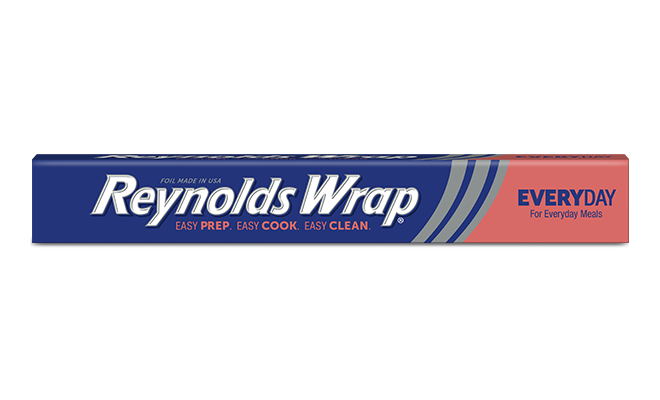The Ultimate Aluminum Foil and Cooking Papers Guide
Explore this cooking papers guide to learn more about how to use cooking papers and aluminum foil commonly used in cooking, baking, prepping, and food storage.
Last updated: October 9, 2024

Versatile Parchment Paper
What is the maximum parchment paper baking temperature?
Parchment paper is made of paper with a food-safe silicone coating that makes it heat-resistant and non-stick. Reynolds Kitchens® Parchment Paper is the perfect option when baking or cooking because it can handle temperatures up to 425°F.
Where can I use parchment paper?
- Oven: Parchment is an excellent choice for the oven to have your cookies slide off the sheet easily or wrap up a delicious, seasoned meal in a parchment packet. However, remain cautious when using: The maximum temperature should not exceed 425°F. Be sure to cut your parchment paper to the exact size of your pan so that it does not hang over and touch the side of the oven or oven racks. Parchment paper should never be used with broiling units or toaster ovens.
- Microwave: You can cover foods, steam vegetables, and reheat leftovers with parchment paper.
- Food prep: Using parchment paper as a countertop liner while prepping or decorating foods helps protect your surfaces and provides a one-step cleanup. You can easily create a piping bag to decorate desserts beautifully. And if you’re ever in a pinch, you can use parchment paper to make your own DIY muffin pan liners.
- Freezer and refrigerator storage: For cold storage, it’s best to use freezer paper. Parchment paper and wax paper are great for separating frozen meats and layering between baked goods, but they’re not airtight for cold storage.
- Air fryer: Reynolds Kitchens® Air Fryer Liners are convenient, pre-cut squares of non-stick parchment paper that make cooking a breeze. Say farewell to stuck-on food and tedious cleanups. They work great in square or round air fryers in temperatures up to 400°F, giving your food that perfect crispy texture you love.
You'll Need...
Air Fryer Liners
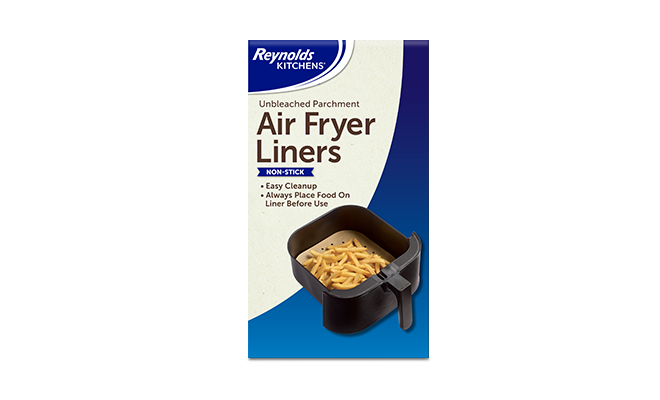
What are the Best Uses for Parchment Paper
For Baking:
- Lining baking sheets and pans: With parchment paper, you can easily transfer cookies to and from the baking sheet and make clean-up a breeze. In addition, line your round cake pans with parchment paper for easy release—your cake won’t cling to the bottom! Grab scissors and learn how to make a round parchment paper liner.
- Creating parchment slings for brownies and bread: A parchment sling is a simple trick to make cleanup easier and ensure your brownies or baked bread comes out of the pan smoothly without sticking. Explore how to make a parchment sling in four easy steps.
For Cooking:
- Making parchment packets: Parchment packets (also called en Papillote) are a simple and convenient way to seal in all the delightful flavors that this Ginger Shrimp & Broccoli En Papillote recipe and other delicate seafood recipes offer. Learn how to make parchment packets in four simple steps.
- Roasting vegetables in the oven: If slow-roasting veggies is your thing, try lining your pan with parchment to keep them from sticking to your baking sheet. And parchment paper makes cleanup easy—no more scraping veggies off the pan! We recommend trying our simple and delicious recipe for Oven Baked Zucchini and Squash Chips.
- Covering or lining foods in the microwave: Prevent messy cleanup by placing a sheet of parchment paper over your microwave-safe dishes or plates when reheating food (this is a great use for wax paper as well). For extra protection, place a sheet of parchment paper underneath your food, too!
- Steaming foods in the microwave: From asparagus to zucchini, parchment paper makes it easy to cook vegetables in the microwave. Place your cut and prepared veggies in a microwave-safe dish, add a little water for steam, cover with parchment paper, and cook according to your microwave’s directions.
Discover more versatile uses for parchment paper in our article Best Uses for Parchment Paper.
Parchment paper vs wax paper
Many ask, “Is wax paper the same as parchment paper?” The quick answer is no. You might consider using wax or parchment paper interchangeably, but these two papers have distinct qualities and serve different purposes. Explore the uses for wax paper vs parchment paper for cooking and baking.
You'll Need...
Parchment Paper With Stay Flat Dispensing
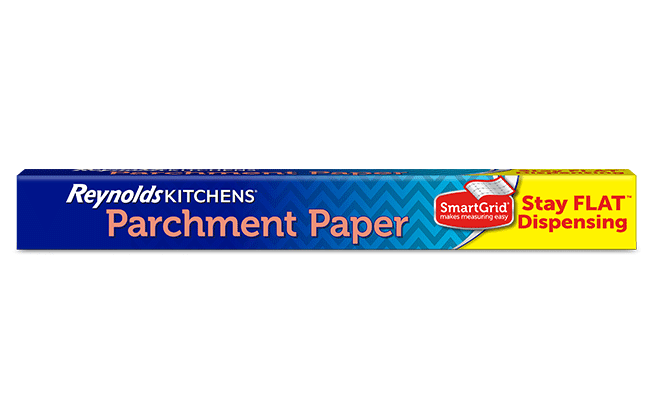
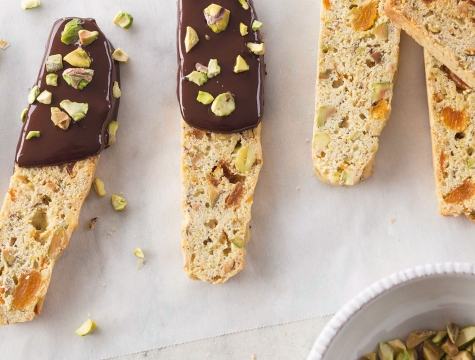
Tried-and-True Wax Paper
What are the best uses for wax paper?
- Wrapping sandwiches: Wax paper is a great choice for wrapping sandwiches! The wax protects against air, preventing your sandwich from drying out and maintaining its freshness. And once you’ve unwrapped it, you have a clean eating surface for your sandwich, too! Without a doubt, wax paper reigns supreme when it comes to selecting a paper wrap for sandwiches.
- Storing hard cheeses: Wrapping hard cheeses, like Parmesan or Asiago, in wax paper has several benefits. It allows the cheese to breathe, provides protection, regulates moisture, and ensures it stays fresh and flavorful and lasts longer.
- Rolling dough: From pie crusts to sugar cookies, you can roll your dough between two sheets of wax paper (parchment paper works great as well). Simply peel the wax paper from the dough, then gather and toss the mess when done!
- Fudge, caramel, and candy making: When making gooey confections like fudge, caramel, and candy, wax paper does an excellent job lining pans, wrapping individual pieces, or creating barriers between layers when storing. Try this Cookies and Cream Puppy Chow recipe that will satisfy your sweet tooth and cleans up quickly using Reynolds Kitchens® Cut-Rite® Wax Paper.
- Lining countertops when decorating cookies & cupcakes: Catch your drips and sprinkles on a sheet of wax paper while you decorate cookies and cupcakes. Tidy up your countertops in a flash when you’re done.
- Covering microwaved foods: Just like parchment paper, wax paper can keep your microwave splatter-free when you use it to cover your foods in the microwave.
- Food prep: To make food prep faster, chop, shred, bread, peel, or grate your ingredients on a sheet of Reynolds Kitchens® Cut-Rite® Wax Paper on your kitchen counter. This way, you can catch every shred on wax paper and save time on cleanup. Once you’re done, simply gather the edges of the paper and dispose of any mess.
Where can I use wax paper?
- Refrigerator: Along with keeping your sandwiches and cheese fresh in the refrigerator, wax paper can keep your fridge looking fresh! Help keep your drawers and shelves clean by lining them with a double layer of wax paper. The sheets help keep moisture and condensation at bay. When there’s a spill, drip, or splatter, just toss out the wax paper and refresh with new sheets.
- Microwave: Wax paper is microwave-safe. Use it generously to cover and wrap your foods for reheating and keep your microwave scrub-free.
- Oven: Wax paper should not be directly exposed to heat in an oven. However, Reynolds Kitchens® Cut-Rite® Wax Paper may be used as a pan liner when baking cakes, bread, brownies, or any baked food when the batter completely covers the wax paper lining and the wax paper is not exposed to heat.
- Other wax paper uses: Discover how to use wax paper as a cookbook protector, a makeshift spoon rest, and other handy wax paper uses.
Wax paper vs freezer paper
We recommend freezer paper as the best barrier against air and moisture, which helps prevent freezer burn. It has a slick, shiny coating on one side that helps keep food moisture from soaking through the paper.
Wax paper will work well if you thaw the food before separating it. However, if you need to separate frozen food, it’s better to use freezer or parchment paper. They are more durable and tear-resistant compared to wax paper when either wet or dry.
You'll Need...
Wax Paper

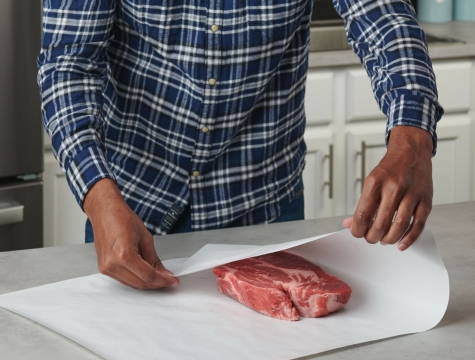
Protective Freezer Paper
Reynolds Kitchens® Freezer Paper is a fantastic tool for preserving food in the freezer. It effectively keeps moisture in and air out, preventing dreaded freezer burn. The paper features a shiny non-stick coating that keeps food moisture from seeping through. Place your foods on the coated side and ensure that the dull paper side faces outward. To make things even more convenient, you can quickly secure the paper with freezer tape and then date and label the outside of the package.
What are the best uses for freezer paper?
- Wrapping and freezing meats and fish: Freezer paper is a perfect choice for wrapping meats and fish because it provides an effective moisture and air barrier, preserving the quality and flavor of the food during freezer storage. It’s also flexible to form securely around various shapes. That’s why it’s been used by butchers and fishmongers for years.
- Arts and crafts: You know those moments when your dining room table becomes an arts and crafts project workstation? You need freezer paper! It’s perfect for keeping your work surfaces safe from spills, and it also does a fantastic job of stopping markers, paints, and glue from seeping through. In addition, quilters can use freezer paper for tracing and sewing applique designs onto a background fabric. Learn how to use freezer paper in quilting.
Where can I use freezer paper?
- Refrigerator and freezer: No surprise here—freezer paper is best for the freezer! You can easily thaw your wrapped meats in the refrigerator once you’re ready to cook them.
- Don’t use it in the microwave: Freezer paper is not microwave safe and should not be used in the microwave. If defrosting your frozen meats in the microwave, always remove the freezer paper first.
- Don’t use it in the oven: Freezer paper is not oven safe. You should never use freezer paper in the oven.
Freezer paper vs parchment paper
While they may look similar, freezer and parchment paper are very different. Parchment paper is suitable for use in the oven up to 425°F and is microwave-safe. Freezer paper is designed for freezing, and not safe for microwave or oven use.
Freezer paper vs butcher paper
Freezer paper and butcher paper are tough papers used to wrap meats, but each has its unique purpose. Freezer paper is designed for long-term storage in the freezer. It has a moisture-resistant coating and thicker construction to keep the meat well-preserved. On the other hand, Reynolds Kitchens® Pink Butcher Paper is commonly used for smoking meats. It is well-known for sealing in the moisture, allowing for tender smoked meat, while still being breathable to protect the meat’s tasty, crisp bark during the smoking process.
You'll Need...
Freezer Paper
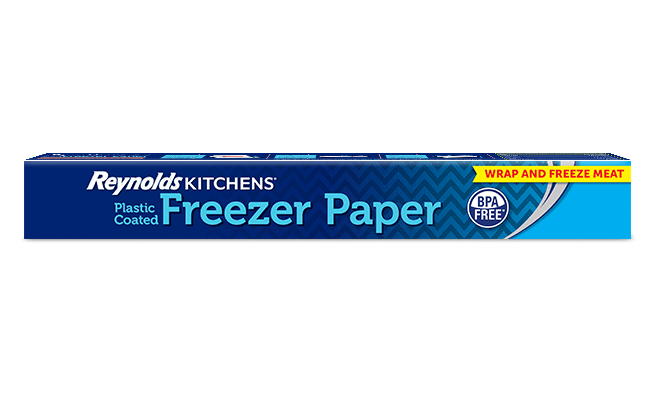

Breathable Butcher Paper
Butcher paper is a food-grade kraft paper designed to wrap raw meat and fish from the butcher or market. It’s also popular to use on the smoker when smoking meat.
Reynolds Kitchens® Pink Butcher Paper is the top pick for many smoking aficionados. This heavy-duty paper is designed to be extra strong, resisting leaks and tears even when exposed to moisture.
What are the best uses for butcher paper?
While people commonly use butcher paper for smoking meats, you can do many other things with it.
- Smoking meats: Most backyard BBQ enthusiasts and pitmasters recommend using butcher paper when smoked meats reach the “stall” stage. Wrapping it in butcher paper speeds up cooking while preventing dryness. It also helps achieve the perfect BBQ combo of crisp bark and juicy, tender meat. For more smoking tips, learn how to use butcher paper for smoking meats.
- Resting after smoking or grilling: Before you cut into that juicy piece of meat that you have grilled or smoked to perfection, remove it from your grill or smoker and wrap it in butcher paper to rest. (Keep in mind, butcher paper shouldn’t be used on or near a grill or open flame—it’s not flame retardant.) Resting your meat in butcher paper for a few minutes will seal in the juices. In some cases, larger cuts will continue to cook, even after being removed from the heat source. Butcher paper may be used after smoking to cut and prepare your meats for serving.
- Wrapping raw meat and fish: Butcher paper is a fantastic short term storage option for wrapping raw meat and fish. It keeps them fresh, allows them to breathe, and absorbs any excess moisture. Plus, it’s an eco-friendly packaging choice.
- Wrapping deli meat sandwiches and subs: Using butcher paper to wrap sandwiches and subs is a great way to give them a classic deli-style look. It also makes them easy to transport and ensures the ingredients stay fresh and intact.
- Presenting or serving your meal: Forget the fancy tablecloth—roll out the butcher paper to cover your table when eating a summer seafood boil or BBQ. Or, line your charcuterie boards with butcher paper for a swift cleanup after the dinner party!
Where can I use butcher paper?
- Smokers: Low and slow cooking is perfect for using butcher paper because it can handle temperatures up to 300°F. Since most smoking is done at temperatures below this, you can confidently use butcher paper for your smoking needs.
- Oven-safe up to 300°F: As long as you keep the temperature at 300°F or below, you can use butcher paper in the oven. Ensure that the paper does not touch the walls or heating elements in the oven. Alternatives for oven use are parchment paper and aluminum foil.
- Microwave: Butcher paper is microwave-safe. Similar to wax and parchment papers, it can be used to cover and wrap foods while reheating.
- Freezer and refrigerator: You can use butcher paper in the refrigerator and freezer for short-term storage. Because its air and moisture permeable, it doesn’t work well against freezer burn, and odors from the freezer or refrigerator may seep into foods.
- Don’t use on a grill: Butcher paper should never be exposed to open flames.
Butcher paper vs parchment paper
Is butcher paper the same as parchment paper? The short answer is no. Parchment paper is paper coated with a special silicone layer, making it resistant to high heat and preventing food from sticking to it. It’s great for baking because it can handle temperatures up to 425°F. On the other hand, butcher paper is better suited for slower cooking methods like smoking, where the temperature stays under 300°F. And it’s not ideal for baking, as it isn’t non-stick and can only be used in lower temperatures in the oven. Remember, parchment paper and butcher paper should never be used near open flames.
You'll Need...
Pink Butcher Paper with Slide Cutter


Multipurpose Aluminum Foil
Aluminum foil is a remarkable kitchen tool that can be used for almost all of your cooking needs, whether you’re making a simple meal or tackling heavier tasks. It’s so versatile that you can use it for baking, cooking, grilling, roasting, and so much more! Reynolds Wrap® Aluminum Foil has been a trusted and essential kitchen companion since 1947. It’s been the go-to choice for storing and cooking food for years. It does a great job of regulating heat, and keeping your pans and grills clean. When used to store foods, it blocks out light and air, but it also helps keep harmful microbes out that can cause food spoilage. Trusty aluminum foil is always there to save time, keep things cleaner, and help prevent foods from spoiling.
What are the best uses for aluminum foil?
- Grilling: Tired of dealing with a messy grill? Reynolds Wrap® Grill Foil is non-stick, extra-strong, and heavy-duty, making it the perfect choice for lining your grill when cooking sticky foods or dishes that tend to fall between the grates.
- Smoking meats: If you’re a fan of the Texas Crutch method for smoking meats, grab extra thick and heavy duty Pitmaster Choice foil for your legendary backyard BBQ creations.
- Wrapping foil pack dinners: Foil packet dinners are the perfect way to make cooking a breeze, especially when grilling or camping outdoors. Wrap your meal, including all your favorite seasonings and sauces, in heavy duty aluminum foil to create a tightly sealed packet that locks in all those incredible flavors. Check out these foil packet recipes for the whole family!
- Roasting: Whether roasting a Citrus Glazed Ham or tenting a roast turkey with foil for your next family gathering, aluminum foil works wonders to keep everything juicy and mouthwatering and easy to clean afterward.
- Lining baking sheets and pans: Lighten up your after-dinner cleanup with aluminum foil. Lining baking sheets and pans with aluminum foil can make cleanup easier, promote even cooking, and protect your pans. Just be mindful of the heat reflection that could speed up your cook times, and avoid highly acidic foods when using foil, as it can affect the taste of your food.
- Covering dishes in the oven: Covering your foods with aluminum foil is an effective way to keep them moist and prevent them from drying out. Remember to watch out for too much steam and adjust the cooking time or remove the foil if you want the tops to get nice and golden or crispy, such as casseroles or pies.
- Warming food and leftovers: If you love the fresh-from-the-oven taste of pizza or other leftovers, aluminum foil is for you! Lay your foods on pans or sheets covered in foil or wrap in foil and reheat them in the oven until their internal temperature reaches 165°F.
- Storing foods in the refrigerator and freezer: Want to keep foods fresh? Use aluminum foil. By sealing the foil tight around the food, you can protect it from moisture, odors, and air, and avoid any cross-contamination from other foods.
- Other uses: Cooking isn’t the only way you can use aluminum foil. There are actually so many ingenious ways to use it. Explore these clever Aluminum Foil Life Hacks.
Where can I use aluminum foil?
- Oven: Overall, using aluminum foil in the oven can be convenient and practical for all your cooking needs. It helps make delicious recipes like this Cheesy Buttery Broiled Shrimp, while saving you from the hassle of scrubbing baked-on messes. Reynolds Wrap® Non-Stick Foil is best to keep cheesy foods from sticking. Use sheets of Reynolds Wrap® Everyday Foil for catching spills under your baking dishes. As a friendly reminder, do not to cover the entire oven rack with foil as it could affect the airflow and cooking times.
- Grills: Aluminum foil is an essential grilling tool. Not only does it make clean-up easier, but it also prevents food from getting stuck in the grates. Additionally, it helps cook your food evenly and can help lock in extra flavor to every bite if used for wrapping.
- Smokers: Along with wrapping your meat during the smoking process, you can also use foil for creating smoke pouches. To add a smoky flavor to your food, fill a small piece of aluminum foil with wood chips or aromatic herbs, seal the pouch tightly, and poke a few holes in it to let smoke escape. Place these pouches directly on top of the hot coals or near the heat source in your smoker for delicious results.
- Campfires: Foil-wrapped meals are a convenient and delicious option for campfire cooking. You can also use aluminum foil as a makeshift grilling surface, heat reflector, or food storage at the campsite.
- Don’t use aluminum foil in the microwave: We don’t recommend using aluminum foil in the microwave, as it can cause sparks and potentially start a fire.
Aluminum foil vs tin foil
Aluminum foil replaced tin foil after World War II because it is less expensive to produce, more durable, and better at conducting heat. Although some people still call it “tin foil,” it is made of aluminum, which is stronger and longer-lasting. Tin foil is made of tin-coated steel or iron and does not conduct heat as well, plus it is not as sturdy.
Parchment paper vs aluminum foil
Parchment paper is great for baking and keeping food from sticking, like baking cookies, roasting veggies, or cooking delicate fish. Suppose you need more insulation for cooking methods like roasting meats, baking casseroles, or reheating food. In that case, aluminum foil is your best bet. Foil is also ideal for high-heat cooking like grilling or broiling.
You'll Need...
Everyday Foil
